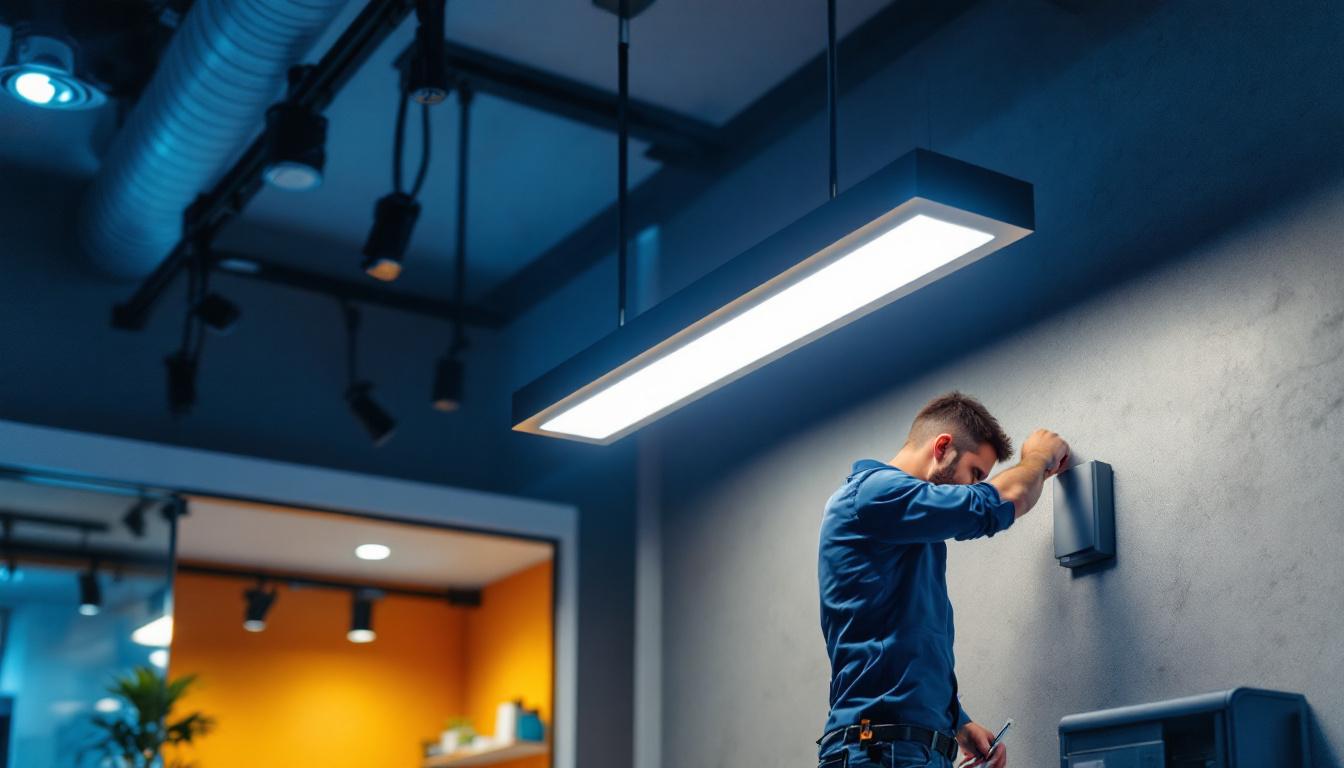
As a lighting contractor, understanding the intricacies of electrical systems is crucial for delivering quality service to clients. One of the most practical innovations in residential and commercial lighting is the light switch for outlets. This guide aims to provide comprehensive insights into the functionality, installation, and benefits of these switches, ensuring that contractors can enhance their offerings and meet diverse client needs.
Light switches for outlets are devices that allow users to control the power supply to an electrical outlet, enabling them to turn on or off lamps and other devices connected to that outlet. This functionality can significantly improve convenience and energy efficiency in a space. By integrating these switches into your home or office, you can easily manage your lighting and electronic devices, creating a more organized and user-friendly environment.
These switches typically operate by interrupting the flow of electricity to the outlet. When the switch is in the “on” position, power flows to the outlet, allowing devices to function. Conversely, when the switch is turned “off,” the flow of electricity is halted, effectively powering down any connected devices. This simple yet effective mechanism not only enhances user control but also contributes to energy savings by reducing the standby power consumption of devices that would otherwise remain plugged in.
It’s important to note that these switches can be wired in various configurations, depending on the specific requirements of the installation. Understanding the wiring diagrams and electrical codes is essential for ensuring safe and effective installations. For instance, a single-pole switch is commonly used for controlling one outlet from a single location, while a three-way switch allows control from two different locations, which is particularly useful in larger rooms or hallways.
There are several types of light switches for outlets, each designed for specific applications. The most common types include:
In addition to these common types, there are also specialty switches designed for specific needs. For example, GFCI (Ground Fault Circuit Interrupter) switches are essential in areas where moisture is present, such as kitchens and bathrooms, as they provide added safety by cutting off power in the event of a ground fault. Furthermore, there are also timer switches that can automatically turn lights on and off at predetermined times, perfect for enhancing security and energy management in your home.
Incorporating light switches for outlets into your projects can provide numerous benefits, both for contractors and their clients. Understanding these advantages can help in promoting this feature effectively.
One of the primary benefits of light switches for outlets is the convenience they offer. Instead of having to bend down to unplug a lamp or device, users can simply flip a switch to control the power. This is particularly advantageous in hard-to-reach areas or for individuals with mobility issues.
Moreover, having a switch located near the entrance of a room allows users to turn on lights as they enter, creating a welcoming atmosphere without fumbling in the dark. This feature is especially useful in larger spaces, such as living rooms or conference rooms, where multiple light sources may be present. With a single switch, users can control the ambiance of the entire room, making it easier to set the mood for gatherings or meetings.
Energy efficiency is another significant advantage. By allowing users to easily turn off devices when not in use, these switches can help reduce energy consumption. This is particularly beneficial in commercial settings where multiple devices may be plugged in and left on unnecessarily.
Furthermore, smart switches can provide insights into energy usage, allowing clients to make informed decisions about their consumption patterns and identify potential savings. These advanced switches can often be programmed to turn off at specific times or controlled remotely via smartphone apps, adding another layer of convenience and efficiency. This capability not only helps in lowering electricity bills but also contributes to a more sustainable lifestyle, aligning with the growing trend of eco-conscious living.
Installing a light switch for an outlet requires a solid understanding of electrical systems and adherence to safety protocols. Here’s a step-by-step guide to ensure a successful installation.
Before beginning the installation, gather the necessary tools and materials. Commonly required items include:
1. **Turn Off Power**: Begin by turning off the power at the circuit breaker to ensure safety during installation.
2. **Remove Existing Outlet**: If replacing an existing outlet, carefully remove it from the wall box by unscrewing it and disconnecting the wires.
3. **Connect the Switch**: Follow the wiring diagram for the specific switch being installed. Typically, this involves connecting the hot wire to the switch and the outlet. Ensure all connections are secure and use wire nuts where necessary.
4. **Mount the Switch and Outlet**: Once wired, mount the switch and outlet back into the wall box and secure them with screws.
5. **Test the Installation**: After securing everything, turn the power back on and test the functionality of the switch and outlet. Ensure that the switch properly controls the power to the outlet.
6. **Safety Check**: After testing, it’s crucial to conduct a thorough safety check. Use a voltage tester to confirm that there are no live wires exposed and that the outlet is functioning correctly. This step is essential to prevent any potential electrical hazards that could arise from improper installation.
7. **Finishing Touches**: Once you’ve confirmed everything is working, consider adding a decorative cover plate to the switch and outlet. This not only enhances the aesthetic appeal of your installation but also provides an extra layer of protection against dust and accidental contact with the wiring. Choose a style that complements your room’s decor, as there are many options available in various colors and finishes.
Safety should always be a top priority when working with electrical installations. Here are some key considerations to keep in mind:
Every region has specific electrical codes that must be followed during installations. Familiarizing oneself with these codes is essential to ensure compliance and safety. Failure to adhere to local regulations can result in hazardous situations and potential legal issues.
Investing in high-quality switches and outlets is crucial for long-term performance and safety. Inferior products may fail over time, leading to potential hazards such as electrical fires or short circuits. Always source materials from reputable suppliers.
While installing light switches for outlets is generally straightforward, contractors may encounter challenges. Being prepared for these issues can streamline the installation process.
One common challenge is dealing with outdated or improperly wired systems. In older homes, wiring may not meet current standards, leading to complications during installation. In such cases, it may be necessary to rewire sections of the circuit to ensure safety and functionality.
Contractors should also be prepared to troubleshoot any unexpected wiring configurations, which may require additional expertise or consultation with an electrician.
In some installations, space may be limited, making it difficult to fit a switch and outlet in the same box. In these situations, consider using a combination unit that integrates both functions into a single device, or explore alternative mounting options that comply with safety standards.
The landscape of light switch technology is constantly evolving, driven by advancements in smart home technology and energy efficiency. Staying informed on these trends can enhance service offerings and attract more clients.
Smart switches are becoming increasingly popular as homeowners seek greater control over their lighting systems. These devices can be integrated with home automation systems, allowing users to control lighting from their smartphones, tablets, or voice assistants.
For contractors, offering smart switch installations can set them apart from competitors, providing clients with modern solutions that enhance convenience and energy management.
Many new light switches come equipped with energy monitoring capabilities, enabling users to track their energy consumption in real-time. This feature can help clients identify high-energy devices and adjust their usage accordingly, promoting more sustainable practices.
Contractors can leverage this technology to educate clients about energy savings and the long-term benefits of investing in smart lighting solutions.
Light switches for outlets represent a significant advancement in electrical systems, providing enhanced convenience and energy efficiency for users. For lighting contractors, understanding the functionality, installation process, and benefits of these switches is essential for delivering quality service and meeting client expectations.
By staying informed about trends in technology and adhering to safety standards, contractors can position themselves as knowledgeable professionals in the field. Embracing innovations like smart switches not only enhances service offerings but also contributes to a more sustainable future in lighting solutions.
Ultimately, the integration of light switches for outlets into projects can elevate the overall client experience, making it a valuable addition to any contractor’s toolkit.
Ready to take your lighting projects to the next level? At LumenWholesale, we provide lighting contractors with the highest quality, spec-grade lighting products at prices that can’t be beaten. Say goodbye to local distributor markups and hello to our extensive selection that meets rigorous industry standards. With free shipping on bulk orders, you can trust that you’re getting the best value without any hidden costs. Elevate your service offerings with reliable, high-performance lighting from LumenWholesale. Wholesale Lighting at the Best Value is just a click away. Enhance your toolkit today and light up your clients’ spaces with confidence and affordability.

Discover effective strategies for lighting contractors to tackle common challenges with LED Type S installations.

Discover everything lighting contractors need to know about 8ft light fixtures in just five minutes.

Discover how lighting contractors can harness the power of solar plant lights to enhance energy efficiency, reduce costs, and offer sustainable solutions.

Discover how sensor outdoor lights can enhance your business with our comprehensive guide tailored for lighting contractors.